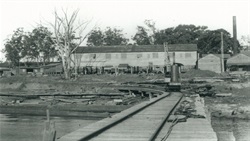Kidman and Mayoh Shipyard
The Commonwealth Government Line
In 1916 the Australian government formed the Commonwealth Government Line of Steamers. The first ships of the Line were a number of former British tramp-steamers and a collection of German and Austrian vessels acquired by Australia at the outbreak of WWI through Prize Law. These ships were used to carry part of Australia's exports of wheat and wool to Europe and the United States. As Allied shipping losses mounted during the war and as demands on shipping increased for the purposes of war and general trade the government embarked in 1917 on a program of shipbuilding.
By July 1918 it had signed contracts for the construction of a small number of steel ships. At the same time it contracted for the building of 24 wooden ships: 12 schooners to be built by Hughes, Martin & Washington in Sydney and the Western Australian Shipbuilding Co in Perth; and 12 barquentines to be built by the Wallace Power Boat Co and the firm of Messrs Kidman & Mayoh, both in Sydney.



Above: Photos of Kidman & Mayoh's shipyard at Kissing Point Park on the Parramatta River, NSW, circa 1919
Kidman and Mayoh's Shipyard
Unlike the other firms contracted by the Commonwealth, Kidman & Mayoh were not shipbuilders. Sid Kidman was a prominent South Australian pastoralist popularly known as the 'cattle king'. The brothers Arthur and Joseph Mayoh were engineers who had come to Australia from England around 1909 and had been involved in the construction of Sydney's underground railway. Kidman & Mayoh leased part of the Cleves Estate at Kissing Point on the Parramatta River. Included in the lease was a large stone house called Cleves, built in the 1840s and for many years the home of Charles Blaxland.
Within a short time slipways had been laid and a timber mill and blacksmiths' shop had been established. By December 1918 one keel had been laid. But the end of the war in November 1918 meant that the need for wooden ships was seen to be over. The government's contracts with Hughes, Martin & Washington and Wallace Power Boat Co were cancelled with due compensation paid. In August 1919 Kidman & Mayoh's contract was varied, reducing the number of ships to be constructed by them from six to two.
The ships were built using timber brought down from the north coast of New South Wales. Hundreds of men, among them champion axeman Charlie Murrill, were employed felling and squaring heavy timber including ironbark for the keels, turpentine for sheathing and ti-tree 'knees'.
'Bush carpenters' from the north coast came down to work in the shipyard, assisting the skilled shipwrights whose labour was in short supply at that time. Some local Putney people got jobs as blacksmiths and labourers.
The 'Braeside' and the 'Burnside'
Early in 1920 the Australian trading company Burns Philp made an offer to the government to buy the two ships being built at Kissing Point. The offer was conditional on the ships receiving a seaworthiness certificate from a Lloyd's surveyor. Burns Philp assigned the names Braeside and Burnside to the hulls and the Braeside was launched at Kissing Point in April 1920. The Sydney Mail reported that she was "the largest wooden ship ever built in Australia", would be rigged as a five masted barquentine and "engaged in the island trade, principally for the direct transit of copra to Great Britain and America."
 Photo: Looking down on the hulls of the 'Braeside' and the 'Burnside' January 1920
Photo: Looking down on the hulls of the 'Braeside' and the 'Burnside' January 1920
Some damage was done to the Braeside on launching due to an insufficient depth of water. Other problems quickly became apparent. Built with a sag of 9" before launching it was found that while afloat she had developed a hog of 23". In other words, the ship was now bent upwards at the midship point to the extent of nearly 2 feet.
In July the Lloyd's surveyor refused to issue a first-class classification to the Braeside. Burns Philp withdrew from the contract and the government resumed responsibility for the ships. Kidman & Mayoh borrowed money from the government to cover the men's wages and took Burns Philip to court over non-payment for work done. By October Kidman & Mayoh were seeking to be relieved of the contract, citing their lack of experience in building ships, high costs and a scarcity of local, suitable timber. They asked the Parliamentary Standing Committee on Public Works to investigate the affair. A saga of litigation followed.
The naval architect, the foreman shipwright, riggers, strikers, blacksmiths, all gave evidence before the Committee. Accusations were made of false fastenings and dummy bolts. When the Committee's report was tabled in April 1921 the government cancelled its contract and began legal proceedings against Kidman & Mayoh. Kidman & Mayoh in turn took legal action against the government. They lost.
Kidman & Mayoh dissolved their partnership in July 1922. The Burnside was finally sold to the Union Box & Timber Company of Annandale who stripped accessible portions of the structure, including the decking. The hull was rendered worthless to other salvagers by the existence of 80 tons of iron bolts and in September 1923 what remained of the ship was burnt on the stocks.
In December 1923 the Braeside was towed outside Sydney Heads and set on fire. It burned through the night. Sid Kidman lost many thousands of pounds on the ship but is reported to have said that his biggest regret was that the wonderful work of the superb axemen of the north coast forests, their enthusiasm, craftsmanship and loyalty, all went for nothing.